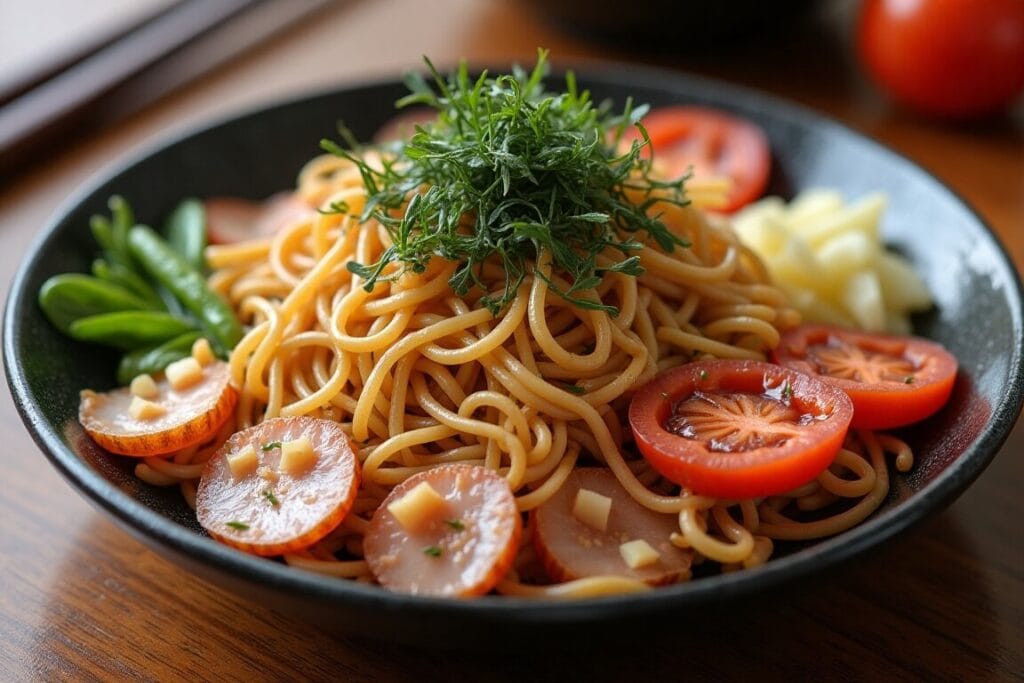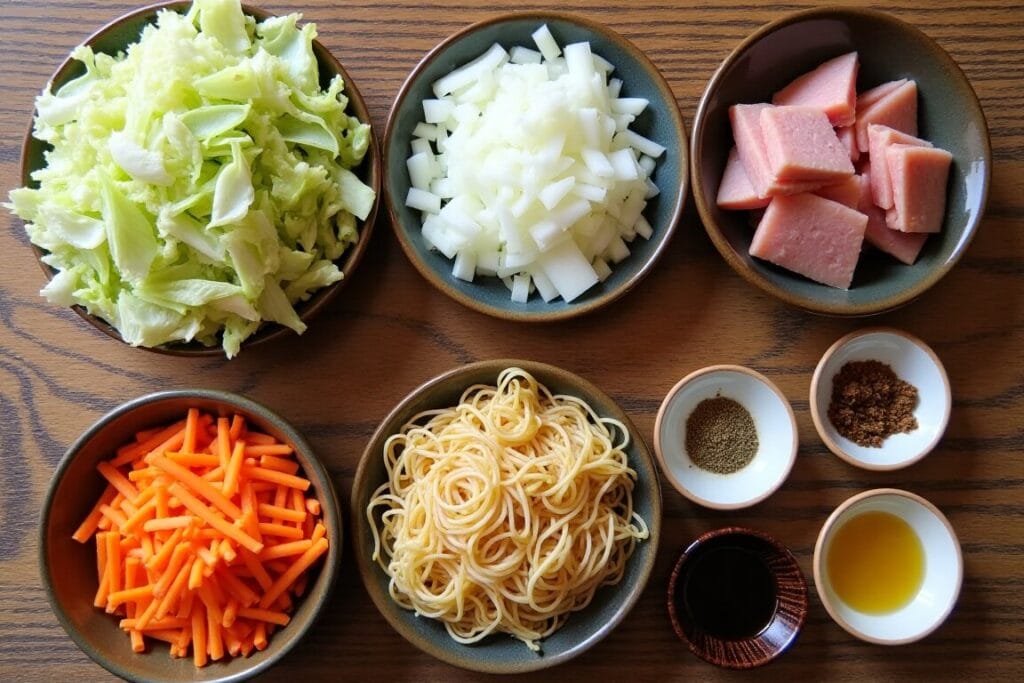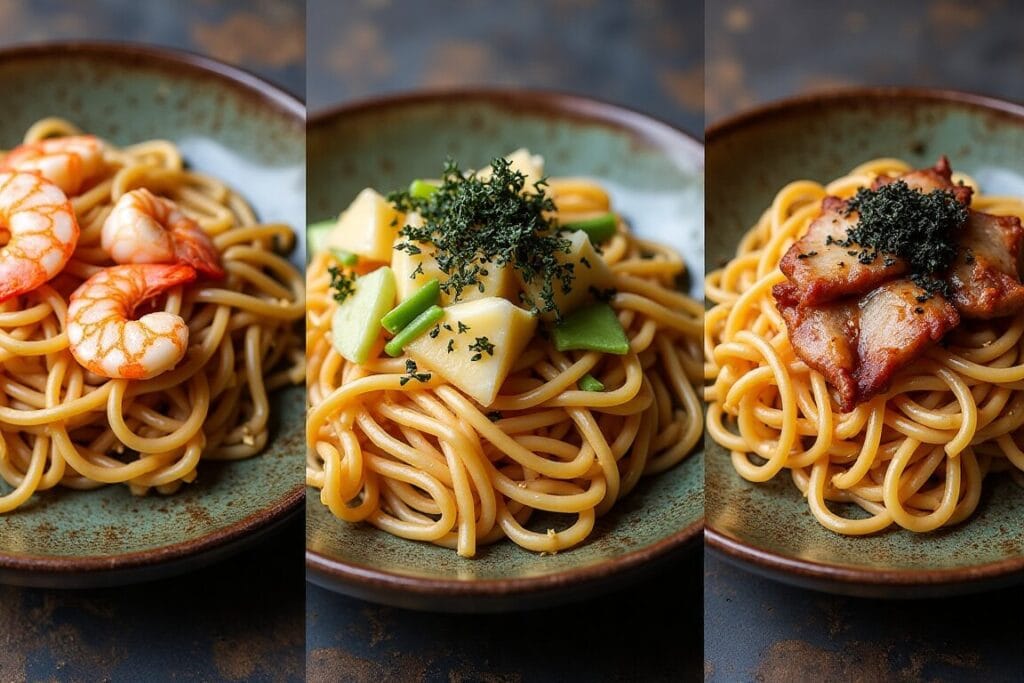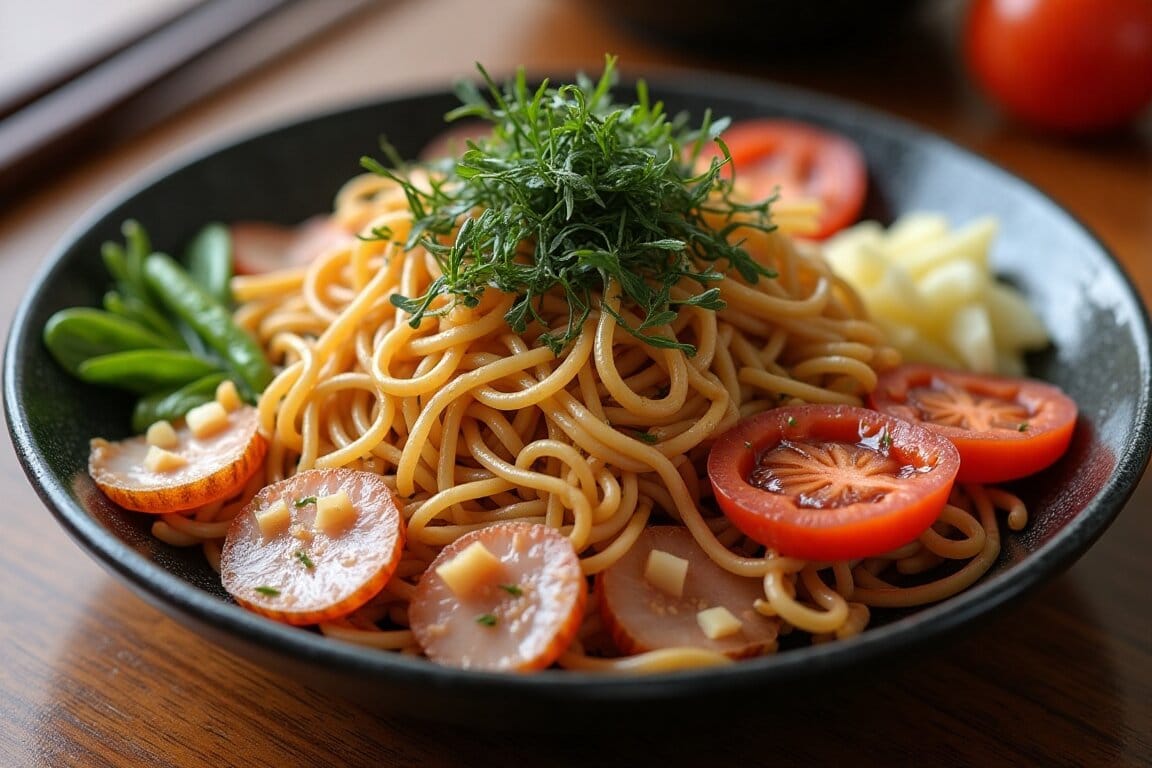Introduction
Yakisoba noodles are a beloved Japanese dish that has captured the hearts of food enthusiasts worldwide. Characterized by their savory-sweet sauce, stir-fried noodles, and a medley of vibrant vegetables and protein, yakisoba is a culinary gem that perfectly balances flavor, texture, and cultural heritage.
Whether you’re a seasoned foodie or someone discovering Japanese cuisine for the first time, yakisoba offers a versatile and accessible entry point. Found at bustling street food stalls during summer festivals or prepared fresh in home kitchens, these noodles tell a story of tradition, innovation, and global appeal.
In this guide, we’ll dive deep into the world of yakisoba, covering everything from its rich history to practical tips for making it yourself. We’ll also explore its variations, nutritional aspects, and the essential tools you’ll need to prepare an authentic dish. By the end, you’ll be ready to savor yakisoba in its full glory.

Origins and History of Yakisoba
Yakisoba, which translates to “fried noodles,” holds a special place in Japanese cuisine. Despite its name, yakisoba isn’t made from soba noodles. Instead, it typically uses Chinese-style wheat noodles, much like those found in ramen dishes. Its story begins with the influence of Chinese cooking, adapted to Japanese tastes over the years.
The Birth of Yakisoba
Yakisoba’s history dates back to the early 20th century when Japanese cooks first experimented with stir-frying Chinese noodles. Inspired by chow mein, a similar dish from China, the Japanese version introduced ingredients like Worcestershire sauce to create its distinct umami-rich flavor.
Initially considered a humble street food, yakisoba became widely accessible due to its simple preparation and affordable ingredients. Post-World War II Japan saw a rise in the dish’s popularity as markets flourished, and stalls began serving yakisoba during public gatherings.
Japanese Street Food Culture
One of the most enduring associations of yakisoba is its role in yatai, or Japanese street food stalls. These small, vibrant setups are especially common at festivals (matsuri), where the tantalizing aroma of sizzling noodles wafts through the air and draws crowds of eager diners. In fact, the dish embodies the spirit of communal celebration and indulgence, as it is often served on paper trays and enjoyed in a lively, festive atmosphere. Moreover, the garnishes, such as pickled ginger (beni shoga) and seaweed flakes (aonori), add both flavor and visual appeal, making yakisoba a true highlight of the street food experience. Therefore, it is no surprise that yakisoba has become a quintessential part of Japanese festival culture.
Evolution of Yakisoba
Over the years, yakisoba evolved from being a festival-exclusive treat to becoming a versatile dish widely embraced in homes, cafes, and restaurants. The introduction of instant yakisoba in the 1950s marked a significant turning point, revolutionizing its accessibility and enabling people to savor the dish with minimal preparation effort.
Modern yakisoba is as diverse as it is beloved. From vegetarian versions to seafood-packed variations, it continues to evolve while staying true to its roots as a quick, satisfying meal.
Ingredients Overview
Yakisoba’s appeal lies in its balance of flavors and textures, created by combining simple, everyday ingredients. Each component contributes to the dish’s character, offering a harmonious medley of savory, sweet, and tangy notes. Whether you’re preparing traditional yakisoba or experimenting with modern twists, understanding the core ingredients is key.
Key Components of Yakisoba

1. Noodles
The noodles used in yakisoba are made from wheat flour and have a springy, slightly chewy texture. These are pre-steamed, making them ideal for quick stir-frying. While not technically “soba,” the name persists due to the dish’s origins.
2. Yakisoba Sauce
The sauce is the star of the dish, lending its signature flavor. Yakisoba sauce typically combines soy sauce, Worcestershire sauce, oyster sauce, and a touch of sugar. This creates a complex, umami-packed profile that perfectly coats the noodles.
3. Vegetables
A mix of fresh vegetables adds color, crunch, and nutritional value. Common choices include cabbage, carrots, onions, and bean sprouts. These ingredients not only complement the noodles but also enhance the dish’s visual appeal.
4. Protein Options
Yakisoba is highly customizable when it comes to protein. Popular options include thinly sliced pork, chicken, shrimp, or tofu for a vegetarian twist. For seafood lovers, squid and scallops are also excellent additions.
5. Garnishes
The final touches are just as important as the main ingredients. Garnishes like pickled ginger (beni shoga), dried seaweed flakes (aonori), and bonito flakes (katsuobushi) add layers of flavor and texture. A drizzle of Japanese mayonnaise can also elevate the dish.
Traditional vs. Modern Ingredients
Traditional Ingredients
Classic yakisoba recipes rely on simple, affordable ingredients found in most Japanese households. The focus is on balance, using just enough sauce to enhance the dish without overpowering the natural flavors of the vegetables and proteins.
Modern Additions
Today, chefs around the world experiment with yakisoba by incorporating non-traditional ingredients. You might find yakisoba infused with spices, topped with a fried egg, or served with unconventional vegetables like kale and bell peppers. These adaptations make the dish more versatile while respecting its origins.
Ingredient Substitutions
1. Noodle Substitutes
If you can’t find yakisoba noodles, ramen or udon noodles can be used as alternatives. For a healthier option, consider soba noodles made from buckwheat or even zucchini noodles for a low-carb twist.
2. Sauce Variations
In the absence of yakisoba sauce, a mix of soy sauce, ketchup, and a dash of vinegar can mimic its flavors. Adding a bit of hot sauce can give the dish an extra kick.
3. Vegetarian and Vegan Alternatives
For plant-based eaters, tofu or tempeh can replace meat, while tamari can substitute soy sauce for a gluten-free version. Be sure to use vegan Worcestershire sauce or make your own for the sauce base.
How to Make Yakisoba
Making yakisoba at home is both enjoyable and rewarding. This step-by-step guide will help you prepare a delicious, authentic dish that’s sure to impress. By following these instructions, you can master the art of stir-fried noodles and customize the dish to your liking.
Step-by-Step Recipe for Yakisoba
Ingredients (Serves 2-3)
- 2 packs of yakisoba noodles (pre-steamed)
- 1/2 head of cabbage, chopped
- 1 medium carrot, julienned
- 1 small onion, thinly sliced
- 200g (7 oz) thinly sliced pork, chicken, or tofu
- 2 tbsp vegetable oil
- 4 tbsp yakisoba sauce (store-bought or homemade)
- Garnishes: pickled ginger, aonori (seaweed flakes), and Japanese mayonnaise (optional)
Instructions
- Prepare Ingredients
- Wash and chop the vegetables into bite-sized pieces.
- If using raw noodles, gently loosen them with your hands or under warm water.
- Cook the Protein
- Heat 1 tablespoon of vegetable oil in a large pan or wok over medium heat.
- Add your chosen protein (pork, chicken, tofu, or shrimp) and cook until golden and fully cooked. Remove from the pan and set aside.
- Sauté Vegetables
- In the same pan, add the remaining oil and stir-fry the onion and carrots for 2-3 minutes.
- Add the cabbage and continue cooking until softened but still slightly crisp.
- Add Noodles
- Place the noodles in the pan with the vegetables. If they stick together, pour a small amount of water (2-3 tablespoons) to help separate them.
- Incorporate Sauce and Protein
- Pour the yakisoba sauce over the noodles and toss to combine evenly.
- Return the cooked protein to the pan and mix thoroughly.
- Serve and Garnish
- Transfer the yakisoba to plates or bowls. Garnish with pickled ginger, seaweed flakes, and a drizzle of Japanese mayonnaise for added flavor.
Tips for Perfect Texture
- High Heat is Key
Stir-frying on high heat ensures that the vegetables stay crisp and the noodles don’t become soggy. Work quickly to maintain the ideal texture. - Avoid Overloading the Pan
Cook in batches if necessary to avoid overcrowding, which can lead to steaming instead of frying. - Loosen Noodles Gently
Use your hands or a bit of warm water to separate the noodles before adding them to the pan. This prevents clumping and ensures even cooking.
Common Mistakes to Avoid
- Using Too Much Sauce
Over-saucing can make the dish overly salty and mask the natural flavors of the other ingredients. Start with a smaller amount and adjust as needed. - Skipping the Garnishes
Don’t underestimate the power of toppings like pickled ginger or seaweed flakes. They add a layer of complexity that elevates the dish. - Not Preparing Ingredients in Advance
Yakisoba cooks quickly, so have all your ingredients chopped and ready before you start stir-frying.
Variations of Yakisoba
Yakisoba’s versatility has led to a wide range of variations that cater to diverse tastes and dietary preferences. From plant-based options to regional specialties, the dish offers endless possibilities for customization. Let’s explore some of the most popular versions and creative adaptations.

Vegetarian Yakisoba
For those following a vegetarian lifestyle, yakisoba can be easily adapted by replacing meat or seafood with plant-based proteins and vegetables.
Ingredients for Vegetarian Yakisoba
- Noodles
- Assorted vegetables (zucchini, bell peppers, mushrooms, and spinach)
- Tofu or tempeh as a protein alternative
- Vegetarian yakisoba sauce (ensure it doesn’t contain Worcestershire sauce made with anchovies)
Preparation Tips
- Pan-fry tofu until crispy before adding it to the dish.
- Use a mix of colorful vegetables for visual appeal and nutritional variety.
Vegetarian yakisoba is just as flavorful as its traditional counterpart and a fantastic option for anyone looking to increase their vegetable intake.
Seafood Yakisoba
Seafood lovers will enjoy the depth of flavor that shrimp, squid, and scallops bring to yakisoba. The natural sweetness of the seafood pairs beautifully with the savory sauce.
Ingredients for Seafood Yakisoba
- Noodles
- Shrimp, squid rings, scallops, or a mix of seafood
- Vegetables like green onions, cabbage, and carrots
- Yakisoba sauce
Preparation Tips
- Sear seafood in the pan first, then set it aside to avoid overcooking during the stir-frying process.
- Add a splash of lemon juice at the end for a bright, fresh flavor.
Regional Variations in Japan
Different regions of Japan put their unique spin on yakisoba, incorporating local ingredients and flavors.
Hokkaido Yakisoba
- Often includes butter and corn, two staples of Hokkaido cuisine.
- Sometimes served with miso-based yakisoba sauce for a rich, hearty flavor.
Hiroshima-Style Yakisoba
- Incorporates noodles layered with fried eggs, vegetables, and proteins.
- Sometimes served with okonomiyaki sauce for a sweeter taste.
Okinawa Yakisoba
- Features thicker noodles and local ingredients like Spam or canned pork, reflecting Okinawa’s culinary influences from American culture.
Modern Creative Twists
- Spicy Yakisoba
Add chili oil, red pepper flakes, or sriracha to create a spicier version. This variation is popular in Western countries where spice is often a favored addition. - Yakisoba with Cheese
A modern twist involves melting cheese on top of the noodles for an indulgent fusion dish. - Fusion Yakisoba Tacos
Wrap yakisoba in soft tortillas for a fun and portable way to enjoy the dish. - Vegan Yakisoba
Use egg-free noodles, tamari in place of soy sauce, and vegan Worcestershire sauce. Load up on vegetables like broccoli, snap peas, and mushrooms.
Customizing Yakisoba to Your Taste
Yakisoba’s adaptability makes it easy to tailor to personal preferences. Whether you prefer more sauce, extra crunch from vegetables, or a protein-packed version, this dish allows for endless experimentation.
Health and Nutrition
Yakisoba is a flavorful and satisfying dish, but its nutritional value depends on the ingredients and preparation methods. With thoughtful choices, you can enjoy yakisoba while maintaining a balanced diet.
Nutritional Value of Yakisoba
Traditional yakisoba provides a mix of carbohydrates, proteins, and fats, making it a well-rounded meal. Here’s a breakdown of its typical nutritional components per serving (approximately 400g):
- Calories: ~500 kcal
- Protein: 15–20g (depending on the protein source)
- Carbohydrates: 60–70g (primarily from noodles)
- Fat: 15–20g (from cooking oil and sauce)
- Fiber: 4–6g (from vegetables)
While yakisoba offers a quick source of energy, its sodium content can be high due to the sauce. Moderation and ingredient selection are key to keeping it healthy.
Tips for Healthier Yakisoba
1. Increase Vegetable Content
- Load up on vegetables to boost fiber, vitamins, and minerals. Consider adding broccoli, bok choy, or spinach for extra nutrients.
2. Opt for Lean Proteins
- Use chicken breast, shrimp, or tofu instead of fatty cuts of meat.
3. Make Homemade Sauce
- Store-bought yakisoba sauce can be high in sodium and sugar. Making your own sauce allows you to control the ingredients. Use a base of low-sodium soy sauce, a touch of honey, and vinegar for a healthier alternative.
4. Reduce Oil Usage
- Limit the amount of oil used for stir-frying. A non-stick pan or wok can help minimize oil without sacrificing flavor.
5. Use Whole-Grain Noodles
- Substitute regular yakisoba noodles with whole-grain or buckwheat noodles for added fiber and nutrients.
Portion Control and Meal Planning
Portion control is essential, especially when indulging in a rich dish like yakisoba.
- Serving Size: Stick to a serving of about 1 1/2 cups per person.
- Pairing: Serve yakisoba with a light side dish, such as a green salad or steamed vegetables, to create a balanced meal.
- Storage: Yakisoba reheats well, making it a great option for meal prep. Divide leftovers into individual portions for easy lunches or dinners.
Common Dietary Adjustments
Low-Carb Diets:
- Use spiralized zucchini or shirataki noodles to reduce carbohydrate content.
Gluten-Free Diets:
- Select gluten-free noodles and ensure that the sauce is made with tamari or a gluten-free alternative.
Vegan Diets:
- Avoid animal-based garnishes like bonito flakes and use vegan-friendly sauces.
Balancing Indulgence with Health
Yakisoba is a comfort food that can be enjoyed without guilt by making mindful ingredient choices. Whether you’re preparing a traditional recipe or a modern twist, small adjustments can make a big difference in the dish’s nutritional profile.
FAQ Section
Are Yakisoba Noodles Healthy?
Yakisoba noodles can be part of a healthy diet when prepared mindfully. The dish’s nutritional value largely depends on the ingredients and portion size. Yakisoba typically provides a good mix of carbohydrates, proteins, and vegetables, offering energy and essential nutrients.
However, pre-made yakisoba sauce can be high in sodium and sugar, so opting for a homemade version is a healthier alternative. To enhance the health benefits, add plenty of vegetables, choose lean proteins like chicken or tofu, and use whole-grain or low-carb noodles if desired. Moderation is key, as yakisoba is often calorie-dense due to the sauce and cooking oil.
Can I Use Spaghetti Noodles for Yakisoba?
Yes, you can use spaghetti noodles as a substitute for yakisoba noodles, especially if traditional yakisoba noodles are unavailable. While the texture of spaghetti differs slightly, it can mimic the springiness of stir-fried noodles when cooked al dente.
To enhance the resemblance to yakisoba noodles:
- Toss the cooked spaghetti with a small amount of oil to prevent sticking.
- Lightly stir-fry the spaghetti in a hot pan to give it a firmer texture before adding the other ingredients and sauce.
Though spaghetti works as a substitute, it’s worth noting that authentic yakisoba noodles are pre-steamed and made from wheat flour, which contributes to their unique chewiness.
How Do You Eat Yakisoba?
Yakisoba is best enjoyed hot and fresh, straight from the pan or wok. It is traditionally served in a shallow bowl or on a plate, often garnished with toppings like pickled ginger, seaweed flakes, or bonito flakes.
Here are some tips for eating yakisoba:
- With Chopsticks: Yakisoba is traditionally eaten using chopsticks, but a fork works well if you’re less comfortable with chopsticks.
- Pairing Options: Pair yakisoba with sides like miso soup, a light salad, or Japanese pickles for a balanced meal.
- Festival Style: If served at a festival, yakisoba might come in a portable paper tray, making it easy to enjoy while walking around.
- Drizzle with Extras: Add Japanese mayonnaise or hot sauce if you like to customize the flavor.
Whether at a festival or your dinner table, yakisoba’s robust flavor and vibrant presentation make it a crowd favorite.
Why Is Yakisoba So Good?
Yakisoba is beloved for its irresistible combination of flavors and textures. The sweet-savory yakisoba sauce, stir-fried noodles, and crisp-tender vegetables create a perfectly balanced dish that appeals to a wide range of palates. Its versatility allows for endless customization, making it a comfort food that can be tailored to individual tastes.
The smoky aroma from stir-frying, the umami-packed sauce, and the variety of toppings like pickled ginger or seaweed flakes elevate the dish to a sensory delight. Additionally, yakisoba holds nostalgic value for many, often associated with Japanese street food culture and festive celebrations, further enhancing its appeal.
Conclusion
Yakisoba is more than just a dish; it’s a culinary experience steeped in culture, flavor, and versatility. Whether enjoyed at a bustling Japanese festival or made fresh in your kitchen, yakisoba embodies the perfect harmony of savory and sweet, with textures that delight the palate.
This beloved dish offers something for everyone, from traditional recipes to creative variations, making it an enduring favorite across the globe. By learning its history, experimenting with ingredients, and mastering the cooking techniques, you can fully appreciate why yakisoba holds such a special place in Japanese cuisine.
The next time you’re craving a quick yet satisfying meal, give yakisoba a try—it’s a simple, delicious way to bring the taste of Japan into your home.

